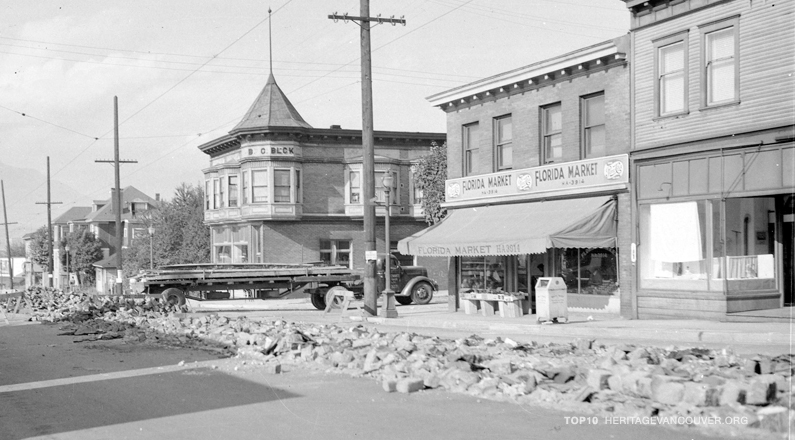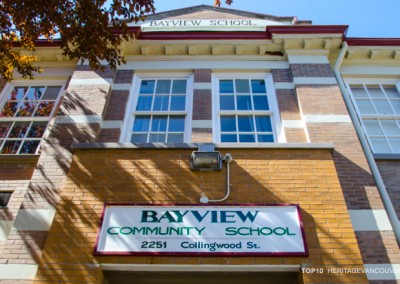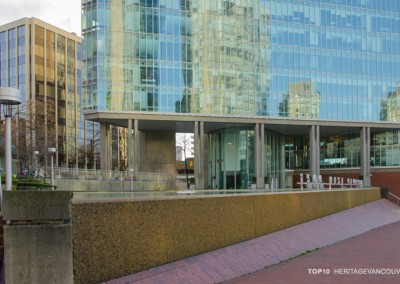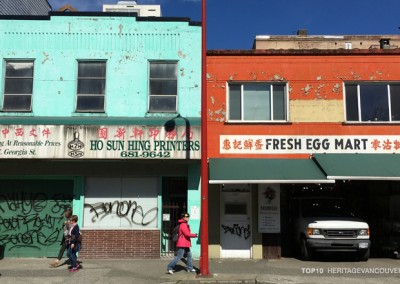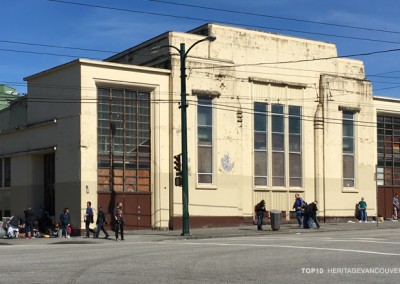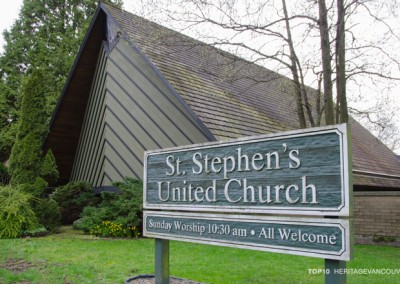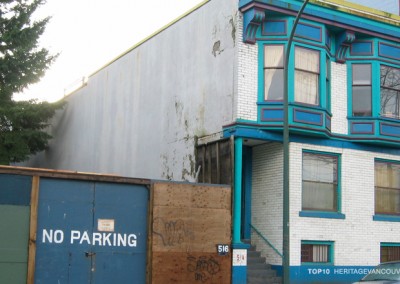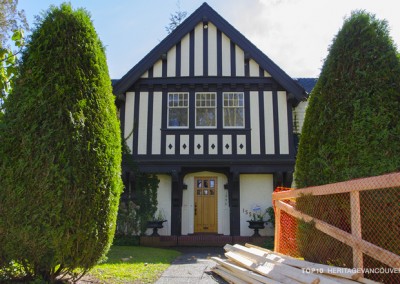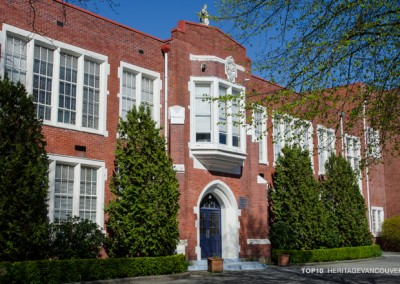Commercial Drive has evolved over the years into a vibrant street that contains an interesting mixture of textures, tastes, cultures and activities. It is outstanding not only for its significant heritage buildings but also for its unique sense of place and experience.
As Vancouver continues to densify, the pressures to develop this area to the current permitted four-storey height limit could create a dreary blandness that would destroy what is important about ‘The Drive.’ Only seven of The Drive’s buildings are listed on the Vancouver Heritage Register.
This year, in 2016, the Grandview-Woodland Area Plan will likely come before Council, and its approval could precipitate a radical shift away from the eclectic mix of people, buildings and public spaces that make The Drive one of Vancouver’s most interesting places.
Threat
What is the threat to Commercial Drive?
Under The Drive’s existing zoning, which provides outright for buildings of four stories, the appealing physical character of Commercial Drive could gradually – or even rapidly – disappear if the forthcoming Grandview-Woodland Area Plan is ratified by the City of Vancouver and there are no special provisions to protect The Drive.
There are a number of heritage buildings dating from the early history of Vancouver right up to the Post-Modernism of the 1980s on The Drive. These range from the multi-storey structures of the original ‘Edwardian Village’ to postwar Modernism and beyond that provide unique retail space and housing. Almost none of these buildings have heritage recognition or protection; only seven of them are listed on the Vancouver Heritage Register.
This is not a unique situation to The Drive, but this is the commercial strip with the highest concentration of potential heritage buildings dating from the early history of Vancouver.
A short stroll up The Drive is a walk through architectural history:
- The east side of the 1300 block has the Dunedin Building at the southeast corner of Charles and Commercial: three-storey, brick-faced with three shopfronts on its main façade, it is a beautiful Edwardian heritage building.
- Next door, the eccentric, colourful Beckwoman’s is a single-storey shopfront, significant for half a century as Fiore Marini’s Shoe Hospital before Beckwoman’s established itself in the 1980s.
- Stripped-down post war Modernism is present in the Post Office sorting facility (1961) and Salvation Army Building (1958), both of which are much less dense than the current zoning; the Salvation Army Building was sold for development in 2015.
- Britannia Community Centre (1976) continues the heritage journey into the utopian 1970s. The mix of schools, community centre and library along with external circulation, peek-a-boo windows, sheltered alcoves and generous public art installations were designed in the collaborative spirit of idealist Christopher Alexander’s “Pattern Language.” The complex is one of the few significant examples of this architectural and historical movement in Vancouver and is budgeted for renewal in the next few years.
- Down the street, the Il Mercado (1986) shopping centre is an example of Post-Modern architecture and urban design principles with a covered internal street, vaguely historicist detailing and pastel colouring. This corner is slated for six-storey buildings under the Grandview-Woodland Area Plan, which is double the size of this building.
Throughout the City, arterial streets have been targeted for densification, without any recognition that some of them have special heritage character that could easily be erased through redevelopment.
The delicate balance between serving local and regional tastes is under pressure on The Drive, as on the other historic streetcar commercial streets. Rising land values threaten to displace the local businesses and to attract new 3-4 storey buildings, with high-rent retail and high-cost residential above. This common building type is allowed under current zoning and would result in a very bland streetscape.
To date, there are only two such buildings, one at Venables and the other, across from Grandview Park at Charles Street. It is not hard to imagine what a street full of these buildings would look like, and how quickly the unique character of The Drive could disappear.
This year, in 2016, the Grandview-Woodland Area Plan will likely come before Council, and its approval could precipitate a radical shift away from the eclectic mix of people, buildings and public spaces that make The Drive one of Vancouver’s most interesting places.
Significance
Why is Commercial Drive significant?
The historic section of Commercial extends from Venables Street south to 12th Avenue. The ‘Edwardian Village’ north of First Avenue is two lanes narrower than the southern section, with only one travel lane in each direction and curbside lanes for parking. This part of The Drive has a more enclosed feel that is in balance with the scale of the buildings, and traffic tends to travel at a slower speed.
Commercial Drive is Grandview’s main street and a popular destination for Vancouver’s residents and tourists. ‘The Drive’, as it is popularly called, began to take shape at the beginning of the 20th century as the local streetcar commercial artery. About 1967, Vancouver newspapers began to identify Commercial Drive as ‘Little Italy.’ The increasing Italian population after WWII in the blue-collar Grandview neighbourhood put a cultural spin on what had been a typical streetcar strip of shops.
The Drive has continued to evolve as a lively mix of businesses, many of which serve the local community, as well as attracting increasing numbers of people from all over the region to its 90+ coffee shops, restaurants and taverns. The unique attractions include alternative cafés, bars, restaurants, theatre and music, car-free days, biking, strolling and, in Grandview Park, activities varying from children’s play to bike polo.
It is the mix of styles and buildings uses that gives Commercial Drive its unique flavour. The Drive’s businesses reflect the history, character and the evolution of the neighbourhood. Groups of Italian and Portuguese men can still be seen socializing outside the many old-style restaurants and coffee shops, or playing bocce in Grandview Park. When Italy’s football club is playing, or during ‘Italian Day,’ the street is immersed in Italian culture. Italian Day, 2014, celebrated ‘Made in Italy’ – from inventions to Italian goods and lifestyle and products of Italian history and culture found in Grandview’s very own backyard. The Co-op bookstore was once home to the Communist Party of Canada.
Many food stores are reminiscent of Vancouver’s hippie days. A number of long-established shops and cooperatives, including the Reach Clinic, reflect the radical beliefs of the 1970s, while others hint at the area’s long-standing reputation as the centre of the city’s lesbian community. High-end maternity and children’s clothing stores reflect the young families now living in the neighbourhood. In restaurants and clubs up and down The Drive, live bands create the funky character the neighbourhood is known for.
Independent businesses, most owned by individuals and families, create a one-of-a-kind feeling to the shops. Chains and big box stores have not yet invaded this fascinating streetscape.
It is not just the range and type of businesses that give the street its unique character. The mix of building styles, heights, rooflines and setbacks all create interest and variety and add to The Drive’s ambience. Between Grant and Kitchener, the undulating roofline of the one, two and three-storey buildings and their uneven setbacks create a very urban rhythm, offering small spaces for buskers and larger ones for sidewalk displays of food and merchandise for sale. Some buildings have a floor or two of apartments above; most storefronts are just 25-feet wide, presenting a rapidly changing set of window displays for the passing pedestrian.
This is arguably the best pedestrian street in the city, its crowded sidewalks attesting to the success of The Drive as an evolved piece of urban design.
Position
Heritage Vancouver’s position
Commercial Drive is an important, largely unmodified, diverse commercial street that reflects Vancouver’s history, heritage and culture from the early 20th century through to the present.
Heritage Vancouver fully supports maintaining both the built form and the unique mixture of businesses that give The Drive its character. The Drive has evolved over the years to adapt to new populations and philosophies and it is important that this evolution continue without destroying the very essence of the street.
We strongly encourage the City of Vancouver to:
- Under the Heritage Register Update undertaken as part of the Heritage Action Plan, many sites on The Drive have been identified as significant heritage resources. Write a letter to Mayor and Council to support the addition of significant heritage sites to the City’s Heritage Register.
As part of the Grandview-Woodland Plan:
- Recognize the most significant part of Commercial Drive as the cultural and historically-significant hub of the Grandview neighbourhood.
- Consider creative planning mechanisms, such as a Heritage Conservation Area Bylaw, which would protect the unique character of The Drive.
- Consider special designation for key blocks as ‘Heritage Streetscapes.’
- Identify tools to allow a natural evolution of the street without destroying its important mix of one-of-a-kind businesses and building styles and streetscapes. This may require limits on site consolidation, building size and storefront width.
Actions
What you can do
We strongly encourage the citizens of Vancouver to:
- Let City Council know that you value ‘The Drive’ and want them to take actions to protect the character of this important street.
- Speak out against poorly-designed replacement buildings that do not reflect the special character of The Drive, and support the evolution of the area to include the best designs of today.
